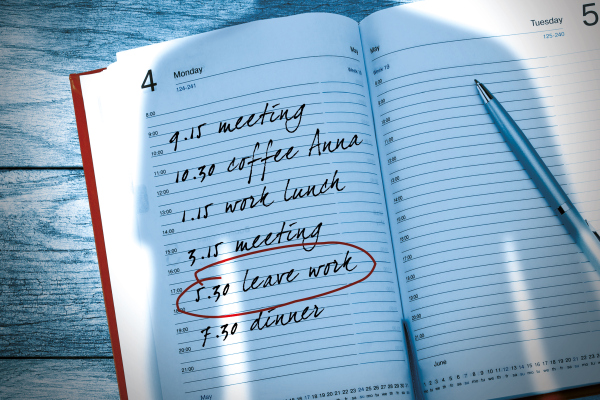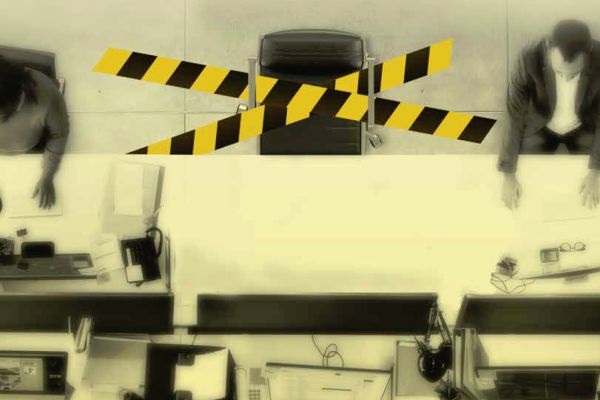The day before my friend died of cancer, I visited her. She was spending most of the time asleep, her husband sitting with her. As I walked into the room, she woke up, saw me and smiled. I leaned over and kissed her. Her eyes grew troubled. ‘He won’t let me talk about it, you know, what’s going to happen. He never wants to talk about it. None of them do.’ I knew what she meant, because she’d mentioned it before: she wanted to talk about her death, and people kept changing the subject. I looked at her husband, who was sitting silently with tears running down his cheeks. He shook his head. I didn’t want to upset him further. So I leaned in to her and said into her ear: ‘Don’t worry, they have all been talking about it. Just not in here.’ She looked at me and smiled again. Then her eyes closed. She died the next day.
I often think about that moment. Should I have sat down with her and said yes, let’s talk about it now, when her husband so obviously didn’t want to? Should I have tried to send him out of the room so we could talk about it? Would it have helped him or made him more upset? I will probably never know. What I do know, though, is that this dilemma is at the very heart of why I am now working alongside Macmillan – to help clients with cancer and their loved ones talk about these kinds of issues.
In the last nine months, I have met an amazing group of people. They have all been going on cancer journeys: their own, or alongside their partners or family members. To protect their confidentiality in this article, I have anonymised, changed and merged details, and changed genders. In addition to my friend, several of my close friends and family have been affected by cancer. Some have survived, and some have not. The statistics are bleak: there are now 2.5 million people living with cancer in the UK,1 and that number is increasing by three per cent every year.1 According to Macmillan research, over 100,000 people of working age (age 16–64) are diagnosed with cancer in the UK each year; more specifically, 327 every day.2–5 This means that there are currently over 700,000 people of working age living with a cancer diagnosis.6 Part of the reason I became a counsellor was because I wanted to make a difference to my clients, and when I began working with this client group, I knew I wanted to give something back.
A new identity
My friend died a few years ago, but her issues around talking about her cancer and death remained with me. And in my work, this is what I hear over and over again – the clients who find that, once diagnosed, they feel isolated. Their new identity as a cancer patient affects not only them but the way they communicate with others. Many clients tell me that, after diagnosis, some of their friends and family simply ‘disappear’. They don’t hear from them at all, or very intermittently, and the dialogue is awkward and uncomfortable. It makes the client feel unloved, unwanted, rejected. They hear that people ‘don’t know what to say’ or begin by being supportive, and then gradually back off when the going gets tough. One client who lived alone, likened it to begging for crumbs of affection from her family, some of whom lived here in the UK and some abroad. She didn’t know whether to stay here to continue with her treatment, but where her family were very unsupportive in spite of the cultural expectations that her uncle would look after her; or to go home to her remaining family and take up treatment options there, in the hopes that her family there would be more kind and caring to her.
The opposite may also occur, when the client prefers to deal with the cancer by minimising it. They may refuse to talk about it because people get upset when they do, or because if they don’t talk about it, then it simply isn’t happening. One client described the way his life suddenly changed overnight to become a ‘soap opera’. He dealt with the situation by not reading any information about his cancer, not reading any of the leaflets issued with his drugs, not talking about it to his children. He put up a front for ages, pretending everything was OK and that the cancer was no more than a slight inconvenience. He hated the phrase, ‘How are you?’ and would turn around and walk off if someone said it. Apparently, I was the only one who was allowed to use it – and that was because I was at the end of a telephone, anonymous, and behind an acceptable barrier.
In both of those cases above, the clients wanted to keep their original identity as ‘people’ and not just become ‘cancer patients’. Most of the work I do with my clients is aimed at helping them to work through various types of loss: the loss of their original identity, the loss of the relationships they thought they had, perhaps the loss of the life that they were expecting to have, and the emergence of a ‘new normal’ that they can work with and come to terms with. One client who had presented with his own diagnosis of cancer, and who was also struggling to get over the death of his wife 10 years earlier from cancer, was really helped when we discussed the idea that his wife would have been going through her own loss for him, in advance of her own death. Sometimes, if clients are really struggling to deal with their loss, I suggest that they can ‘schedule’ themselves in some time to deal with it, say between 3pm and 4pm every day, or at a time to suit them. During this time, they can make sure they are alone, and give in completely to the grief or misery, knowing that there is a ‘stop’ time. Putting boundaries around the time when they allow themselves to feel miserable seems to stop the worst of the feelings from leeching into the rest of the day. Discussing what clients’ expectations were of themselves following the illness, and managing other people’s expectations and judgments of them, is also a large part of the work, as is normalising the clients’ feelings and the apparently rejecting behaviour of their loved ones. The client can lead in these interactions, letting their friends/family/colleagues know that it’s OK to not know what to say or do, and that they can figure out a new ‘script’ or way of being together.
Challenges at work
Loss of identity can also be a problem in the workplace, where clients, who had previously felt they were part of a ‘work family’, may now be suffering from a lack of interaction with their team, or of information about structural changes or new projects taken on. For these people, work is important in terms of normality, routine, stability, social contact and income. What really made a difference to my clients who were off sick from work was the attitude of their workplaces towards their illness. While some clients reported positive experiences, such as one client who had received lots of phone calls, flowers and letters on a regular basis from her work colleagues, unfortunately this is not always the case. One client who had been off for nine months with skin cancer had had little or no contact from his manager or colleagues, even though he had tried to stay in touch. He didn’t hear anything until he had a letter from HR telling him that he was able to qualify for long-term disability, but if he chose to take that, it would affect his pension and pay. He described how he had been made to feel like a ‘faceless person’. This was compounded by a phone call informing him that, while off sick, his whole department had been restructured, he had a new boss, and that he didn’t qualify for the Access to Work that he was expecting.
In England, Scotland and Wales, employees with cancer are protected from discrimination in the workplace by the Equality Act 2010. The Disability Discrimination Act 1995 and its extension, the Disability Discrimination Order of 2006, protect workers in Northern Ireland. Cancer is legally defined as a disability, but apparently 71 per cent of employers are not aware of this.7 In theory, responsible employers should have policies and practices in place to ensure that all employees with cancer are treated fairly and appropriately. However, according to some of my clients, their managers and colleagues were not confident about how to support them. This is upheld by more Macmillan research, which states that almost half of people living with cancer and in work when diagnosed (47 per cent) say their employer did not discuss sick pay entitlement, flexible working arrangements, or workplace adjustments, when they informed them of their diagnosis.8 Those who have returned to work after cancer may also face challenges. Around four in 10 people who are working when diagnosed have to make changes to their working lives after cancer, with almost half changing jobs or leaving work altogether; while of those who give up work or change jobs as a result of their diagnosis, 43 per cent give up work because they are not physically able to do it.10 One client had a phased return to work, but she felt she had to deliver her job immediately after her return, almost to behave as if she hadn’t just had cancer. She described a sense of guilt about the time she had had to take off to deal with her illness. Her colleagues were also reluctant to talk to her about what she had been through, and because her body had changed as a result of surgery, she felt like an oddball. Eventually, she changed her job.
There are some specialist cancer EAP providers. Those workplaces who offer this or internal counselling services show a duty of care; and for clients who can access these services, this is a bonus. Whether it is face-to-face, telephone or online counselling, the fact that this can be dovetailed with HR procedures, alongside their team, will help to create feelings of inclusion. Some clients have been signposted following their workplace support when they have needed further assistance, commonly after a changed prognosis. Their initial EAP counselling has been valuable to these clients.
A question of choice
Whether in the workplace or at home, clients often feel that they have no choice about what is happening to them. I look at this through a different lens: in the client’s world of limited choices, what choices do they have? This is an interesting philosophical point, which I often address with the help of Viktor Frankl.9 ‘When we can no longer change a situation,’ he says, ‘we are challenged to change ourselves.’ His idea is that in a world where you have no choices at all, the one freedom that can’t be taken away from you is the way you choose to respond to the circumstances in which you find yourself. I have often discussed this with clients and found that in some cases they are already doing it. One client was recently diagnosed as terminally ill, with a secondary cancer on the liver, but he was choosing to concentrate on the best way to spend his remaining time. He reacted to his situation by getting a new job and working alongside a friend, painting greetings cards, which he had always wanted to do. He wondered if there was something wrong with him for wanting to do this, but when looked at through the lens of choice, he was able to make sense of his actions. Another client, after we had discussed this choice, decided that she would stop lying awake every night and panicking about what was going to happen to her, and instead get up and start the novel she had always wanted to write. My friend, who I mentioned at the beginning, exercised her choice of how to react to her terminal cancer by making sure that she wore everything in her wardrobe that she had been saving for a special occasion. You would sometimes turn up to find her wearing a ball gown, or a cocktail dress and gloves. The choice of how to respond to your situation is always yours, and clients find it a relief to discover that there is another option.
Terminology
We talk about cancer as a ‘battle’ which must be ‘fought’ and the disease must be ‘beaten’. The cancer is attacked with knives in surgery, poisoned with chemotherapy or blasted with radiotherapy. Cancer patients may have ‘lost their battle’ or have ‘survived’ the attack. Make no mistake, to be living with cancer is to be living in a war zone. However, usually it’s not the fighting talk that I hear from my clients. It’s more likely to be anxiety, depression, worry about family, accompanied by a heavy use of euphemisms for cancer. In addition to ‘The Big C’, which most clients hate, I have heard them talk about abnormal growths, a cluster of cells, maybe a large mass or seedlings. Although a study has found that even though these kinds of terms are often used by doctors and patients instead of that big, scary word ‘cancer’, the employment of euphemisms and the general ambiguity generated by their use can cause more anxiety than the actual word itself.10
I have also found that clients, when they first present, are very ‘medicalised’, due to their interaction with a series of hospital professionals. They usually want to tell you the story of their cancer and treatment so far. They see me as yet another professional, and as a result, they use a lot of jargon, which for me, with my journalistic rather than clinical background, can be baffling. Terms such as lumpectomy, which I had heard of, and mucositis, which I hadn’t, cropped up. I got confused between MRI, CT and PET scans. There are more than 200 types of cancer, each with its own name and treatment. I felt overwhelmed with the sheer amount of information that I received when I was doing my initial training with Macmillan. No wonder my clients felt the same.
I realised that I had to find a way of working with the cancer in the room. It had to have its own space, to almost sit in the empty chair. I often externalise it, asking clients to give me a visual picture of how they see it, or feel it in their body. Descriptions have ranged from ‘a grey slug’, ‘an alien inside me’, ‘a black cloud’, feeling ‘under attack’, ‘rotten in my chest with cells going everywhere’ and even ‘an inconvenience’. Clients have talked about their bodies betraying them, their cancer holding them back like a harness, and have even given it a name such as ‘Matilda’ or ‘Bert’. Once they can ‘see’ it, talk or shout at it, or even decide to make it smaller or more transparent, it becomes less threatening. It becomes a real thing rather than an all-encompassing menace; something that can be fought, or recognised and accepted.
Ultimately, some of my clients are staring death squarely in the face, but would struggle to talk about that too. More euphemisms were used by the clients’ loved ones and their doctors. I heard ‘kicking the bucket’, to ‘pop one’s clogs’, ‘pushing up daisies’, ‘to bite the dust’, and my personal favourite: ‘to become living-challenged’. Almost anything rather than use the word ‘died’. I have noticed, particularly when doing genograms, that people often use ‘passed away’ for someone close to them who has died recently, and keep ‘died’ for an event that happened a while or a generation ago. As a therapist, I would often be the one to use that word before the client did, even if they found it shocking, so that we could then begin to open up a dialogue about what death means to them, how it has been dealt with in their families, and inevitably to talk about the concept of a ‘good death’. Clients have found it helpful to be able to talk to someone about their worries around dying alone, dying in pain, dying in fear, and how it might look and feel at the end of life. Some clients have been used to talking about death in relation to others, either as part of their job if they worked in a medical setting, or because others in their families have died; but are surprised that they struggle to talk about it in relation to themselves. A couple of clients wanted to talk through their fears of suffering in the same way that they had seen someone else suffer. I find that, when you are talking about almost certain death at an unknown time,11 it is useful to help the client to set goals that they can work towards, so that they have some sense of achievement. One client wants to live long enough so that her grandchildren are old enough to remember her. As the disease progresses or the goals are achieved, new goals can be set, with shorter lead times, so that there can still be a sense of satisfaction. Talking about, and making plans for, their eventual death has also been a part of the work: thinking about who they want to be there, where they want to be, and even what they want to wear; so that the unknown can become, in some small way, known.
Closing thoughts
Providing this space, where it is OK to talk, and safe to suffer, means that as a therapist I need to look after my own self-care. The work that I do is relatively short term, usually eight sessions or less, so it feels as if you vividly but briefly dip into the client’s journey while they come to terms with what is happening to them. Clients also drop out of therapy for various reasons, such as denial, or treatment. I have regular supervision, of course, and sometimes I have simply dumped my feelings at my supervisor’s feet. One thing I do find useful is to type short process notes when I get home. Once I have emptied my head onto paper – and I am a fast typist so it doesn’t take long – I find that I don’t carry my clients around with me too much. But sometimes, no matter how well prepared you feel, a client’s story can shock you or make you tearful. Today, I shed a few unexpected tears in the room with a client as we talked about facing death. Last Friday, I found myself welling up as another client talked about how she had now come to think of death as a ‘state of mind’. In the interests of congruence in these situations I always acknowledge my feelings to the client, and they seem to appreciate this.
Of course, most of the time and as with most clients, you will never know the end of the story. Some people will recover, some will return to work successfully, some will manage without taking much time off work, and others unfortunately don’t survive. If treatment is successful, work can provide a constancy and security, whereas for others, it’s a time to do something else or a time to make sense of what has happened. I would like to think that eventually my clients and their loved ones will be able to talk about their feelings to each other. It’s OK to be human, after all.
Caroline Feldon Parsons MBACP has been a practising counsellor with Relate for four years. She currently works with individuals, couples and families, and alongside Macmillan with clients and families affected by cancer. Before that, she worked at the BBC for 28 years as researcher, producer and director within various network radio and TV departments.
More from Counselling at Work

The training gap
Open article: Employee support is a growth area in the therapy world, but the opportunities for trainees to find placements are scarce. Nicola Banning finds out how one pioneering EAP is responding to bridge the gap. Counselling at Work, Spring 2017

When stalking comes to work
Open article: We are all creatures of habit, and stalkers rely on this. The workplace can be one of the most dangerous places for victims of stalking. Rachel Horman explains how employers can safeguard against it. Counselling at Work, Winter 2016

"I’m in trouble at work"
Open article: When an employer begins formal procedures our clients are rarely prepared for the psychological effects. Patrick Quinn outlines the specific skills that counsellors need to help support clients through the process. Counselling at Work, Autumn 2016
References
1 Maddams J, Utley M, Møller H. Projections of cancer prevalence in the United Kingdom, 2010–2040. British Journal of Cancer 2012; 107: 1195–1202. (Projections scenario 1). Macmillan analysis based on extrapolation of 2010 and 2020 projections that the number of people living with cancer will hit an estimated 2.5 million in 2015.
2 Office of National Statistics. Cancer registration statistics, England, 2012. http://www.ons.gov.uk/ons/publications/re-referencetables.html?edition=tcm%3A77-352128 (accessed July 2014).
3 Welsh Cancer Intelligence and Surveillance Unit. Official statistics – trends. http://www.wcisu.wales.nhs.uk/officical-statistics-exel-files-of-trend (accessed July 2014).
4 ISD Scotland. Cancer Incidence in Scotland 2012. http://www.isdscotland.org/Health-Topics/Cancer/Publications/data-tables.asp?id=1233#1233 (accessed July 2014).
5 Northern Ireland Cancer Registry. Online statistics. http://www.qub.ac.uk/research-centres/nicr/CancerData/OnlineStatistics/ (accessed July 2014)
6 Department for Work and Pensions. Organisations’ responses to the Disability Discrimination Act, 2009 study . http://research.dwp.gov.uk/asd/asd5/rports2009-2010/rrep685.pdf (accessed July 2014).
7 NCIN. Macmillan-NCIN work plan. Segmenting the cancer survivor population: by cancer type, 20-year prevalence at the end of 2010, UK. NCIN; 2013. Available from: www.ncin.org.uk/view?rid=2493 (Accessed July 2014).
8 Macmillan Cancer Support/ YouGov online survey of 1,740 UK adults living with cancer. Fieldwork took place between 26 July–9 August 2010. Survey results are unweighted. Stats quoted here are based on people who have completed treatment for cancer within the last year.
9 Frankl VE. Man’s Search for Meaning. London: Random House; 2004.
10 Hauser D, Schwartz N. The war on prevention: Bellicose cancer metaphors hurt (some) prevention intentions. Personality and Social Psychology Bulletin 2015; 41(1): 66–77. DOI:
10.1177/0146167214557006pspb.sagepub.com
11 Glaser BG, Straus, AL. Awareness of dying. Chicago: Aldine; 1966.
